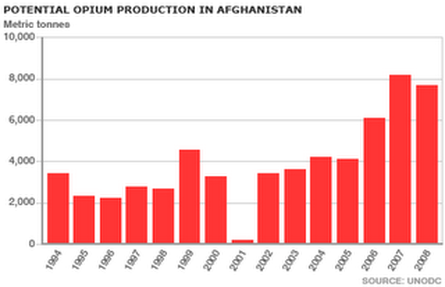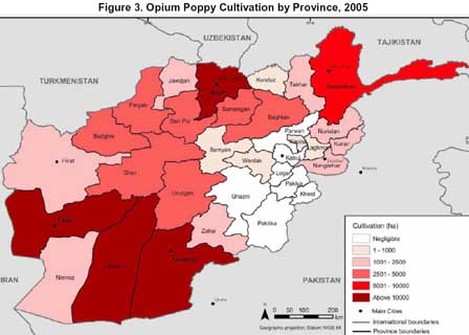Opium Trade
Table of contents
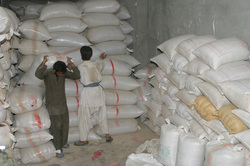
- What is opium?
- History of Opium Trade
- Impacts of Opium Trade
- Efforts to stop Opium Trade
- References
what is opium?
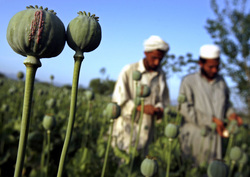
Opium poppy seeds are a crop that is grown (as shown to the left) in mainly parts of Asia. Once the seeds have grown to their full size, they are cultivated and turned into opium. Opium is used in many ways. It is used for the production of many legal drugs, including papaverine and noscapine. One of the most commonly known way opium is used is for the synthesis of morphine. Morphine is a drug that is used primarily as a pain reducer. Heroin can also be synthesized from the opium poppy seed. The ancient Chinese are known for smoking opium originally for medicinal purposes. Smoking opium slowly changed from medicinal purposes to recreational purposes (Kouros, 2010).
History of opium trade
The beginning of opium poppy cultivation in Afghanistan has been traced back to the 18th Century. The first official record of opium production was reported in 1924 to the League of Nations. Poppy cultivation continued, growing steadily, until it was banned in 1945. In 1979, the invasion of Soviet Russia created the legitimate agricultural infrastructure of Afghanistan to crumble. Many Afghan farmers turned to growing opium poppy. There are two major reasons why this transformation from legitimate farming to illegal farming occurred. First, there was a large market for opium and heroin in southwest Asia. In the early 1970s, Turkey, Iran, and Pakistan (the major suppliers of opium and heroin in the world) enforced strict anti-poppy cultivation laws. Second, a large percentage of the profits gained from poppy cultivation was used to supply Afghani rebels with weapons and supplies to resist the Soviet invasion (Farrell, 2004).
From the time that the Soviets occupied Afghanistan in 1979 to 1989, opium production increased at an amazing rate of 15% annually. After Soviet Russia removed itself, Afghanistan was left divided and without a dominant governmental entity. This created an even larger opportunity for opium poppy cultivation, which continued to grow drastically. "By 1994 when the first comprehensive United Nations survey of opium poppy in Afghanistan was conducted, 71,500 ha of Afghanistan was under opium poppy cultivation. By this time, Afghanistan was established as the world's major source of illicit opium, accounting for an estimated 60% of potential global illicit production" (Farrell, 2004). Many officials believed that because of the "uniqueness" of Afghanistan, an effort to stop the production of opium and heroin would be ineffective. In 2001, the Taliban enforced strict anti-poppy cultivation laws. In that year, the total opium production was a mere 185 tons (the previous year was 3276 tons). However, with the fall of the Taliban shortly after 2001, the production of opium shot back up to 3400 tons in the year 2002. Today, Afghanistan still cultivates and produces a large amount of opium poppy and heroin (Farrell, 2004).
From the time that the Soviets occupied Afghanistan in 1979 to 1989, opium production increased at an amazing rate of 15% annually. After Soviet Russia removed itself, Afghanistan was left divided and without a dominant governmental entity. This created an even larger opportunity for opium poppy cultivation, which continued to grow drastically. "By 1994 when the first comprehensive United Nations survey of opium poppy in Afghanistan was conducted, 71,500 ha of Afghanistan was under opium poppy cultivation. By this time, Afghanistan was established as the world's major source of illicit opium, accounting for an estimated 60% of potential global illicit production" (Farrell, 2004). Many officials believed that because of the "uniqueness" of Afghanistan, an effort to stop the production of opium and heroin would be ineffective. In 2001, the Taliban enforced strict anti-poppy cultivation laws. In that year, the total opium production was a mere 185 tons (the previous year was 3276 tons). However, with the fall of the Taliban shortly after 2001, the production of opium shot back up to 3400 tons in the year 2002. Today, Afghanistan still cultivates and produces a large amount of opium poppy and heroin (Farrell, 2004).
Impacts of opium trade
The Opium Trade in Afghanistan has impacted the people and the country as a whole significantly in the past few decades. There have been positive and negative outcomes. The Opium Trade was a major source of revenue for the rebel Afghans during the Soviet Russia invasion. When the Soviets invaded Afghanistan, the people did not have the financial resources to resist. After opium poppy seed plantations began to flourish, many rebel Afghan organizations began to receive large donations from the plantation owners. This gave the Afghanis the necessary resources to purchase weapons and equipment to fight Soviet Russia. Cultivating opium poppy seed strengthens local economies in Afghanistan (Goodhand, 2000).
efforts to stop opium trade
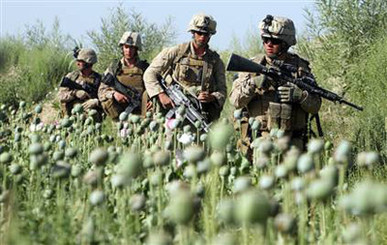
The Opium Trade is supplying anti-government groups with financial resources. This fact alone is the reason why the US government (and others) want to stop the Opium Trade in Afghanistan. The Opium Trade also is also contributing to the Public Health Crisis. Heroin is derived from the opium poppy seed and creates drug abuse and a high number of cases of HIV (caused by using infected needles to inject heroin). Support has been increasing to destroy poppy seed plantations by aerial chemical spraying. The US government have started pressuring the Afghanistan government to crack down on the Opium Trade and eradicate poppy seed plantations. Currently, the US does not support aerial chemical spraying; however, they do want to eradicate opium poppy seed plantations by other means (Werb, 2008).
References
Farrell, Graham. (2005, March 1). Where have all the flowers gone? The International Journal of Drug Policy, 16 (2)
Goodhand, Johnathan. (2000, June). From Holy War to Opium War. Disasters, 24 (2)
Kouros, D., Tahereh H. (2010, May 1). Opium and Heroin Alter Biochemical Parameters of Human's Serum. American Journal of Drug and Alcohol Abuse, 36 (3)
Werb, D., Kerr, T., Montaner, J., Wood, E. (2008). The Need for an Evidence-Based Approach to Controlling Opium Production in Afghanistan. Journal of Public Health Policy, 29 (4)
Goodhand, Johnathan. (2000, June). From Holy War to Opium War. Disasters, 24 (2)
Kouros, D., Tahereh H. (2010, May 1). Opium and Heroin Alter Biochemical Parameters of Human's Serum. American Journal of Drug and Alcohol Abuse, 36 (3)
Werb, D., Kerr, T., Montaner, J., Wood, E. (2008). The Need for an Evidence-Based Approach to Controlling Opium Production in Afghanistan. Journal of Public Health Policy, 29 (4)
